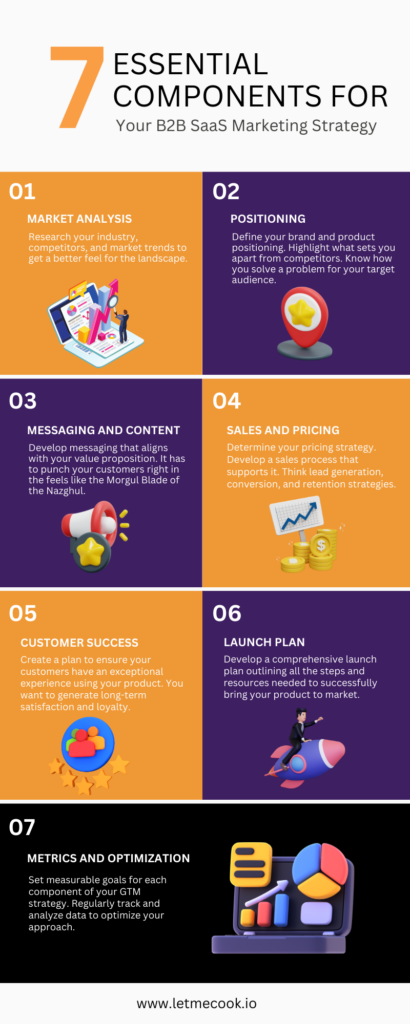Carving out a niche for your product and reaching your target audience hinges on the effectiveness of your B2B SaaS go-to-market (GTM) strategy.
A well-designed GTM strategy illuminates the path to product success. It also sets the stage for sustained growth and scalability.
Are you going to incorporate AI? Interactive content? Augmented or virtual reality? How are you going to differentiate your business and your product?
Things are changing. Hubspot found that almost 80% of marketers think their industry has changed more in the last three years than in the 50 years prior.
You must develop a robust B2B SaaS go-to-market strategy before you launch. It has to align with your product’s unique value proposition and speak directly to your ideal customers.
How do you do it? Step one: keep reading.
Table of Contents
Know the Basics of a B2B SaaS Go-To-Market Strategy
Before we dive into the intricacies of designing a B2B SaaS go-to-market strategy, it’s essential to understand what it is and why it matters.
Think about the Lord of the Rings Trilogy. The entire first movie was nothing but Gandalf cruising around on a carriage and assembling a team of warriors to protect a motley crew of hobbits.
The goal was to destroy the ring. But he needed the right strategy and the right people in place to meet that goal. The Fellowship of the Ring was his GTM strategy.
What about you? You’re Gandalf in this scenario. What’s your strategy?
Simply put, a GTM strategy is a holistic plan outlining how to bring your product to market and achieve your business goals.
It encompasses all aspects of
- Marketing
- Sales
- And, customer success
It Better Be Delicious
It may not be the whole enchilada. But it’s the filling. And if you don’t stuff it right, no one will eat it.
We’re talking about identifying target markets and positioning your product. It covers delivering exceptional customer experiences and driving revenue.
A well-crafted GTM strategy is the foundation of a successful product launch, sustained growth, and market dominance.
GTM SaaS – One Ring to Rule Them All
In B2B SaaS, where competition is fierce, having a clearly defined GTM strategy puts you ahead of the game.
It helps you stand out in a crowded marketplace. It ensures that you focus your efforts on the right audience. A great GTM SaaS strategy leads to better conversion rates and customer retention.
You’ll provide a roadmap for your team that lights the path through each stage of the product journey. And you’ll do it with a unified purpose and direction.
B2B SaaS Product Marketing – It’s All About Value

A clear and compelling value proposition lies at the heart of every successful B2B SaaS product marketing strategy.
Your product’s unique value proposition sets it apart from competitors and resonates with your target audience. To design an effective GTM strategy, you must know and live by your product’s value proposition and its relevance to your target market.
It’s your heart.
Your soul.
Your reason for being.
Start by identifying your product’s key features and benefits. Think about how they solve a problem or address customer needs.
Conduct market research to understand the pain points of your ideal customers and how your product can provide a solution.
Your value proposition should be specific, measurable, and relevant.
Now…Go Get ‘Em Tiger
A B2B SaaS go-to-market strategy is only effective if it speaks directly to the people who will use your product.
Start by creating buyer personas – detailed profiles of your ideal customers based on demographics, behavior patterns, pain points, and goals.
Use these personas to inform your messaging, content, and targeting throughout the GTM process. This will ensure that your strategy speaks directly to the needs and desires of your target audience.
These people aren’t just customers. They’re your tribe. Your family. Bring them home. It’s where they belong.
But you have to convince them of that truth. It won’t always be easy.
Now for a puzzle within a puzzle.
Go-To-Market Strategy for B2B SaaS – 7 Essential Components

We have our foundation. The Fellowship is formed. It’s time to start the long walk to Mordor.
It’s time to build your GTM strategy.
Every go-to-market strategy for B2B SaaS companies will have a unique approach. Some essential components and steps to include in any successful strategy:
- Market Analysis: Research your industry, competitors, and market trends. You’ll get a better feel for the landscape. And to stick with the theme – you’ll know if orcs are afoot.
- Positioning: Define your brand and product positioning. Highlight what sets you apart from competitors. Know how you solve a problem for your target audience.
- Messaging and Content: Develop messaging that aligns with your value proposition. It has to punch your customers right in the feels like the Morgul Blade of the Nazghul.
- Sales and Pricing: Determine your pricing strategy. Develop a sales process that supports it. Think lead generation, conversion, and retention strategies.
- Customer Success: Create a plan to ensure your customers have an exceptional experience using your product. You want to generate long-term satisfaction and loyalty.
- Launch Plan: Develop a comprehensive launch plan outlining all the steps and resources needed to successfully bring your product to market.
- Metrics and Optimization: Set measurable goals for each component of your GTM strategy. Regularly track and analyze data to optimize your approach.
Navigating the GTM SaaS Marketing Journey: Planning, Execution, and Optimization
Developing a B2B SaaS go-to-market strategy is an ongoing process that requires continuous planning, execution, and optimization. As your product evolves and the market changes, so should your tactics.
Regularly review and update your:
- Value proposition
- Target audience insights
- Messaging
- Content
- Pricing and sales strategies
- Customer Success
Every good recipe evolves from one generation to the next. Maybe ingredient availability changes. Maybe someone develops an allergy.
It’s important to maintain fluidity. Keep your current goals aligned with marketplace trends. Keep walking to Mordor. You’ll face obstacles. Some may even feel insurmountable. But if you keep grinding, you’ll persevere.
This is why you need a strong GTM strategy in place. Take a step back, and you can see its role in the whole enchilada. Do it well, and your product is sure to thrive. It will achieve its full potential.
But before we let you go, there are some potential pitfalls to remember. Even if you do everything else right, they can dismantle your efforts.
5 Pitfalls to Avoid in Your B2B SaaS GTM Approach

While there is no one-size-fits-all approach to creating a successful B2B SaaS GTM strategy, entrepreneurs should avoid some common pitfalls. These include:
- Slacking on Research: Have you ever tried to take an exam after spending the whole semester cutting class and not doing homework? It’s the same concept in the business world. Not putting in the research is one of the main reasons startups fail.
- Inconsistent Messaging: Confusing or inconsistent messaging can turn off potential customers. They’ll feel a disconnect, leading to a lack of trust in your brand.
- Ignoring Customers: Neglecting the customer experience can result in poor retention rates and damage your reputation. This has to be a priority in an industry that relies on the subscription model.
- Bad Planning: Successful launches require careful planning, resources, and execution.
- Neglecting Data Analysis: Regularly tracking and analyzing data is crucial in optimizing your approach and achieving long-term success.
Knowing what not to do is as vital as knowing what you should do.
They go hand in hand. Do this. Don’t do that.
Avoiding these pitfalls will help you stay on track. Stay dedicated to continuous learning, adaptation, and customer satisfaction. Your product has a better chance of thriving in this brutal environment.
We Should Mention the Importance of Leveraging Data
Data is a powerful tool for businesses to gain insights and make informed decisions.
B2B SaaS companies should leverage data in all aspects of their GTM strategy. It starts with market research and goes to your customer service efforts.
Regularly tracking and analyzing data helps identify patterns and trends that can enhance your approach.
This includes understanding the following:
- Which marketing channels are most effective
- What messaging resonates with your target audience
- Which pricing strategies lead to the most conversions
Data also allows for ongoing optimization of your GTM strategy.
Track and adjust your approach based on data insights. You stay ahead of the competition and ensure that your product meets your market’s evolving needs. It’ll make your GTM plan much easier.
Your B2B SaaS Go-to-Market Strategy – Wrap Up Your Enchilada
Or throw the ring in the lava. Whichever analogy you want to use is fine. Either way, crafting a successful B2B SaaS go-to-market strategy is a critical yet multifaceted endeavor.
B2B SaaS product marketing requires in-depth market research. You’ll need a clear unique value proposition, consistent messaging, and an unwavering commitment to customer success.
A strong launch plan and diligent metrics tracking and optimization further strengthen your GTM SaaS approach.
Avoid common pitfalls such as inconsistent messaging, neglecting customer success, or underestimating the power of a well-executed launch.
Data is a powerful ally in any B2B go-to-market strategy for B2B SaaS startups. It aids in continuous optimization and informed decision-making.
By following the insights and steps outlined in this guide, you’re on your way to carving a successful GTM strategy. It will set your B2B SaaS product on a trajectory for success in the competitive market.




